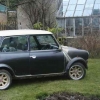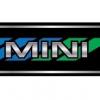Banded Steel Wheels
#1

Posted 11 March 2014 - 10:46 PM
#2

Posted 11 March 2014 - 10:49 PM
Yes, yes, in the way all wheels affect driving, Yes and about 5.5 inches depending on offset
I am running 10x6.5 banded steels, they are awesome in my opinion, any steel wheel can be banded but make sure you go with someone with experience of banding wheels, 12x5 or 12x5.5 wont affect the way it drives really as its about what came standard, they are as legal as any welding on a car
#3

Posted 11 March 2014 - 10:53 PM
#4

Posted 11 March 2014 - 10:55 PM
Couple of pics in this thread of mine, I have 10x 5.5. Yet to be driven on ![]()
#5

Posted 11 March 2014 - 10:56 PM



There we go ![]()
#6

Posted 11 March 2014 - 10:57 PM
Edited by megamini_jb, 11 March 2014 - 10:58 PM.
#7

Posted 11 March 2014 - 11:02 PM
#8

Posted 11 March 2014 - 11:04 PM
#9

Posted 11 March 2014 - 11:34 PM
Also Alex, where did you get the black bumpers from.? Minispares?
They look good don't they,
Its called Halfords Satin black ;) standard grey bumpers tarted up, same colour and finish as the wheel arches
#10

Posted 12 March 2014 - 01:13 PM
Banded steel wheels, if done correctly (and there are more than a few people who have that capability), are safer than any alloys (which ALWAYS have a very finite fatigue life), and are fully legal. The key thing is indeed the offset, so you always need two bands, inboard and outboard of the wheel centre. The important thing is to keep the scrub radius identical to what it was originally, and that almost always means that the two bands will be of unequal widths. People often get the scrub radius badly wrong, with terrible effects on the handling. It can even be quite dangerous, e.g. Metro hubs on a Mini.
The scrub radius is the lateral distance between the centre of the tyre to road contact area and the steering axis, the line through top and bottom ball joints. The thrust due to engine power, or drag due to braking, acts at the centre of the contact patch, and results in force feedback to the steering because it is offset from the steering axis, which gives "feel".
You ideally need a CAD drawing, or a good scale cross-section drawing from a manual or whatever, to see what you have, and how much you need to adjust each edge of the wheel to maintain the status quo. But there is a complication, the tyre does not sit flat on the road, so if you have lots of negative camber, where is the centre of the contact patch? It is commonly taken to be the tyre centre line, but I believe that to be incorrect unless the camber angle is small.
Someone will probably come along with the exact numbers that you need, but what I have said will hopefully help you to understand why it should be so.
#11

Posted 12 March 2014 - 02:03 PM
All sounds very complicated, I would imagine wheel bearing life would be compromised too?
1 user(s) are reading this topic
0 members, 1 guests, 0 anonymous users


















